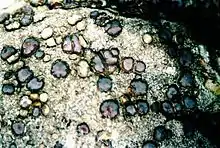Acarosporaceae
The Acarosporaceae are a family of fungi in the order Acarosporales. Members of this family have a widespread distribution, and are mostly lichenized with green algae.[1] According to a 2021 estimate, the family contains 11 genera and about 260 species.[2] The family is characterised by a hamathecium formed of paraphysoids (hyphal structures similar in function to true paraphyses, but often branched and forming a network).[3]
| Acarosporaceae | |
|---|---|
 | |
| Sarcogyne regularis | |
| Scientific classification | |
| Domain: | Eukaryota |
| Kingdom: | Fungi |
| Division: | Ascomycota |
| Class: | Lecanoromycetes |
| Order: | Acarosporales |
| Family: | Acarosporaceae Zahlbr. (1906) |
| Type genus | |
| Acarospora A.Massal. (1852) | |
| Genera | |
|
See text | |
Phylogeny
Formerly classified in the fungal order Lecanorales, phylogenetic analyses in 1998 suggested that the Acarosporaceae belong outside this order;[4] further analysis supported this conclusion.[5] The Acarosporaceae is the most basal family in the division Lecanoromycetes.[6]
Description
Most members of the Acarosporaceae are lichenised, although a rare few are lichenicolous. The form of the thallus ranges from crustose to squamulose to peltate-somewhat umbilicate. The ascomata are in the form of apothecia, which are usually immersed in the thallus. They are typically lecanorine, although a few are biatorine, and Polysporina and Sarcogyne have lecideine apothecia. The photobiont partner is chlorococcoid (i.e., green algae from the family Chlorococcaceae). Various lichen products have been reported in the family, including depsides, depsidones, and derivatives of pulvinic acid. Most Acarosporaceae species grow on land or on rock.[7]
Genera
These are the genera that are in the Acarosporaceae (including estimated number of species in each genus, totalling 261 species), according to a 2021 review of fungal classification.[2] Following the genus name is the taxonomic authority (those who first circumscribed the genus; standardized author abbreviations are used), year of publication, and the estimated number of species.[2]
- Acarospora A.Massal. (1852) – ca. 200 spp.
- Caeruleum K.Knudsen & Arcadia (2012) – 2 spp.
- Glypholecia Nyl. (1853) – 3 spp.
- Lithoglypha Brusse (1988) – 1 sp.
- Myriospora Nägeli ex Uloth (1861) – ca. 10 spp.
- Neoacrodontiella Crous & M.J.Wingf. (2019) – 1 sp.
- Pleopsidium Körb. (1855) – 4 spp.
- Polysporina Vězda (1978) – 10 spp.
- Sarcogyne Flot. (1851) – ca. 30 spp.
- Timdalia Hafellner (2001) – 1 sp.
- Trimmatothelopsis Zschacke (1934) – 11 spp.
References
- Cannon PF, Kirk PM (2007). Fungal Families of the World. Wallingford, UK: CAB International. p. 1. ISBN 978-0-85199-827-5.
- Wijayawardene, N.N.; Hyde, K.D.; Dai, D.Q.; Sánchez-García, M.; Goto, B.T.; Saxena, R.K.; et al. (2022). "Outline of Fungi and fungus-like taxa – 2021". Mycosphere. 13 (1): 53–453. doi:10.5943/mycosphere/13/1/2. S2CID 249054641.
- Roux, Claude; Gueidan, Cécile; Navarro-Rosinés, Pere; Monnat, Jean-Yves (2016). "Encore Trimmatothelopsis!". Bulletin de la Société linnéenne de Provence (in French). 67: 159–163.
- Stenroos, Soili K.; DePriest, Paula T. (1998). "SSU rDNA phylogeny of cladoniiform lichens". American Journal of Botany. 85 (11): 1548–1559. doi:10.2307/2446481. JSTOR 2446481. PMID 21680313.
- Lutzoni, François; Pagel, Mark; Reeb, Valérie (2001). "Major fungal lineages are derived from lichen symbiotic ancestors". Nature. 411 (6840): 937–940. doi:10.1038/35082053. PMID 11418855. S2CID 4414913.
- Miadlikowska, Jolanta; Kauff, Frank; Högnabba, Filip; Oliver, Jeffrey C.; Molnár, Katalin; Fraker, Emily; et al. (2014). "A multigene phylogenetic synthesis for the class Lecanoromycetes (Ascomycota): 1307 fungi representing 1139 infrageneric taxa, 317 genera and 66 families". Molecular Phylogenetics and Evolution. 79: 132–168. doi:10.1016/j.ympev.2014.04.003. PMC 4185256. PMID 24747130.
- Jaklitsch, Walter; Baral, Hans-Otto; Lücking, Robert; Lumbsch, H. Thorsten (2016). Frey, Wolfgang (ed.). Syllabus of Plant Families: Adolf Engler's Syllabus der Pflanzenfamilien. Vol. 1/2 (13 ed.). Berlin Stuttgart: Gebr. Borntraeger Verlagsbuchhandlung, Borntraeger Science Publishers. p. 117. ISBN 978-3-443-01089-8. OCLC 429208213.